Do you sometimes enjoy spaghetti, tortellini, or fusilli as part of a nice dinner? Well, now is your chance to enjoy a delightful specialty from southern Germany instead.
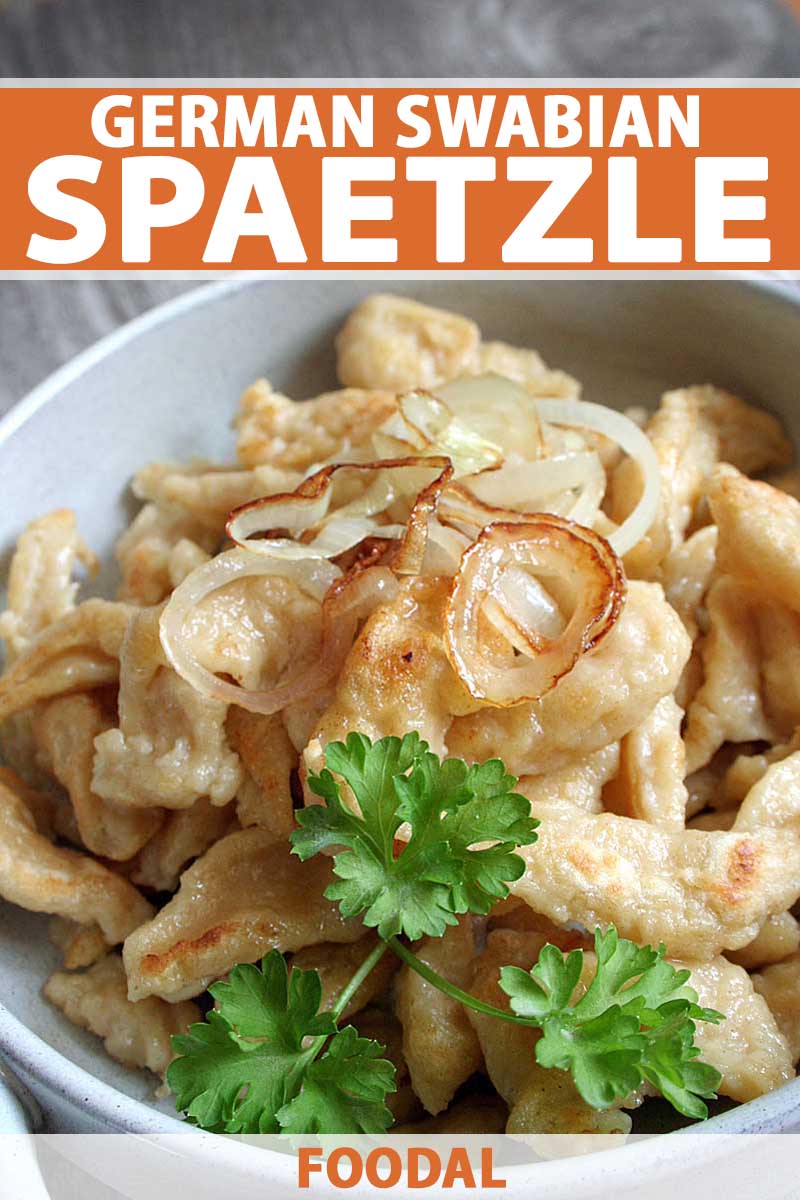
Beware: spaetzle should not be confused with Italian macaroni! The Swabians are very proud of their flagship dish, with its own centuries-long tradition.
The dough is what makes all the difference between better-known types of pasta and this recipe. The Swabian version is more moist, softer, and it would tear apart if you tried to work it and roll the dough like pasta.

You can actually trace the documented preparation of spaetzle back to the 18th century, with written records going back as far as 1725, and perhaps even earlier.
Believe it or not, the traditional food even had it own poem. No surprise, when you consider that the name could be a diminutive form of the German word for sparrow (Spatz). Quite a charming history, don’t you think?
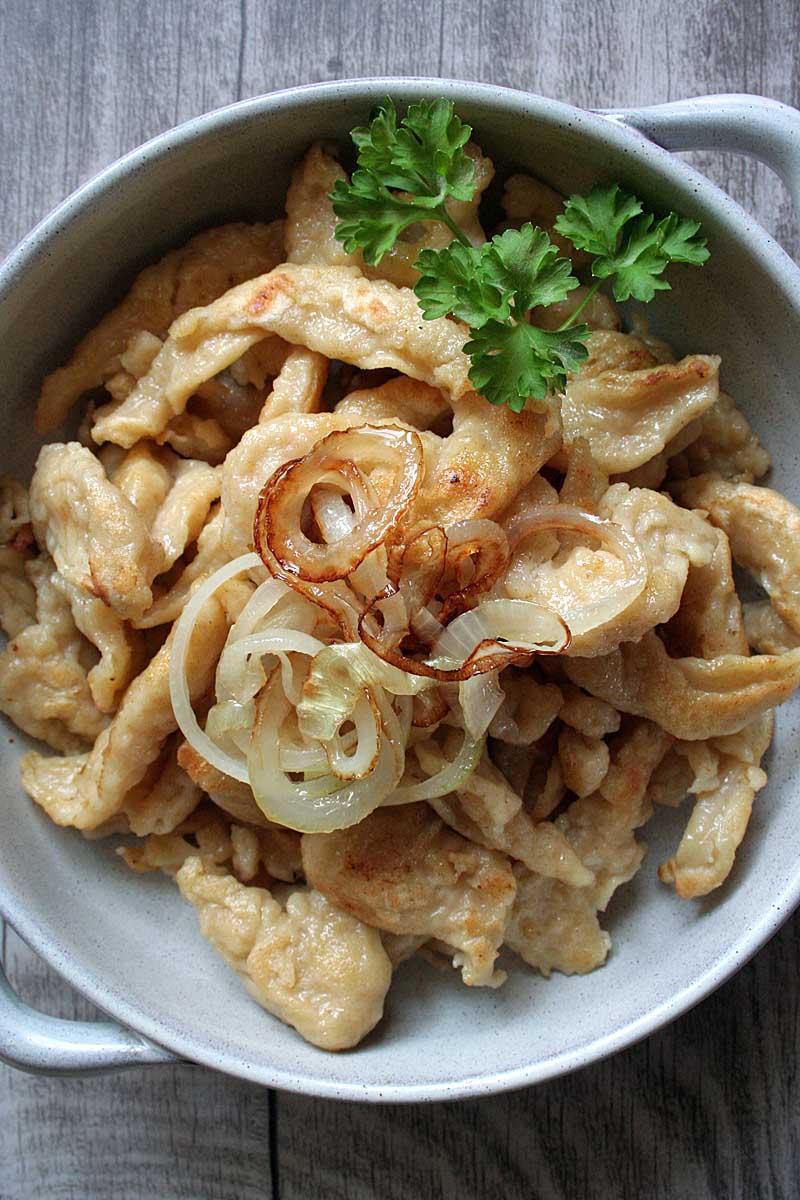
This dish is traditionally prepared by hand, with a wooden board and a kitchen scraper.
This might require some practice, but you shouldn’t worry too much since the individual pieces are meant to look a bit rustic. After a few attempts, you should be able to scrape your homemade spaetzle perfectly.

Be sure to also check out our recipe for Swabian “pockets,” which are similar to ravioli (just don’t tell that to anyone from Stuttgart!) and their version of the potato dumpling.

Original German Swabian Spaetzle
- Total Time: 20 minutes
- Yield: 4 people 1x
Description
Are you ready for some fabulous fare from the “old country?” Try German spaetzle! This German noodle dish can be prepared many different ways but our recipe uses the Swabian variation of adding sautéed onions and cheese for yummy comfort that’s quick and easy to make.
Ingredients
- 9 oz all purpose flour ((about 2 cups))
- 2 eggs
- 1/2 tsp salt
- 6 tbsp water
- butter (to taste)
- Salt and Pepper (to taste)
Instructions
Basic Noodles
- Bring a large pot of salted water to a boil on the stove. While this is heating, sift the flour into a bowl.
- In another bowl, whisk the eggs with the salt and water.
- Gradually add the egg mixture to the flour and whisk together by hand or using an electric mixer until the batter is well beaten and bubbly, without any clumps of flour.
- Using a spaetzle maker or cutting board and bench scraper (or a long, think chef’s knife) spread a thin layer of dough onto the board and slowly scrape strips directly into the boiling water.
- After 3-5 minutes, the first spaetzle that were added to the pot will begin bobbing to the top. This means they are cooked. They can be taken out with a skimmer and put into a colander to drain.
- Toss to coat with butter and add a sprinkling of salt and pepper. Serve hot.
Optional Frying and Topping
- Lightly pan fry in butter until light brown and a bit crispy.
- Serve sprinkled with grated cheese, crumbled bacon, chopped fresh herbs, or sautéed onions.
Notes
These noodle are fairly easy to make, especially if you have a stand mixer to assist in the preparation of the dough.
Note: dietary information calculated for basic noodles only. No toppings were included.
- Prep Time: 15 mins
- Cook Time: 5 mins
- Category: Pasta
- Method: Stovetop
- Cuisine: German
Keywords: German Food, Oktoberfest, Pasta, Swabian
Cooking by the Numbers…
Step 1 – Prepare the Dough
While you bring a large pot of salted water to a boil on the stove, it’s time to prepare the dough.
Sift the flour into a large mixing bowl or the bowl of a stand mixer, and set it aside. In another smaller bowl, combine the eggs, salt, and water. I like to stir these together into fully combined, using a large balloon whisk.
Gradually add the egg mixture to the flour, whisking together completely between each addition. Continue to mix until the batter is well aerated and bubbly, and no clumps of flour remain.
Step 2 – Scrape the Spaetzle
You’re ready to make some macaroni! If you have a spaetzle maker, now’s the time to use it. These come in a variety of shapes and materials, but this usually consists of a top piece for pouring the dough into, and a bottom piece with holes for extruding the dough that looks something like a box grater.

If you don’t have one of these, no problem – it’s simple to use other multipurpose kitchen tools that you already have on hand, like I do here. Grab a cutting board and a bench scraper, or a long chef’s knife.
What you want to do is place your thick batter onto the board, and scrape just a thin stripe to end edge, and directly into your pot of boiling water. Continue to do this until you have done this with all of the mixture.
Step 3 – Boil and Drain
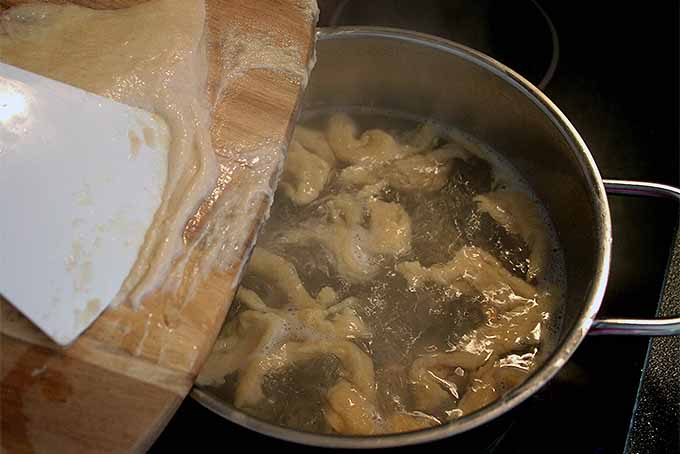
Within just a few minutes, your noodles will begin rising to the top of the bubbling water, a good indicator that they are finished cooking. Remove them carefully with a skimmer or slotted spoon, and place them into a colander if you like, to continue draining.
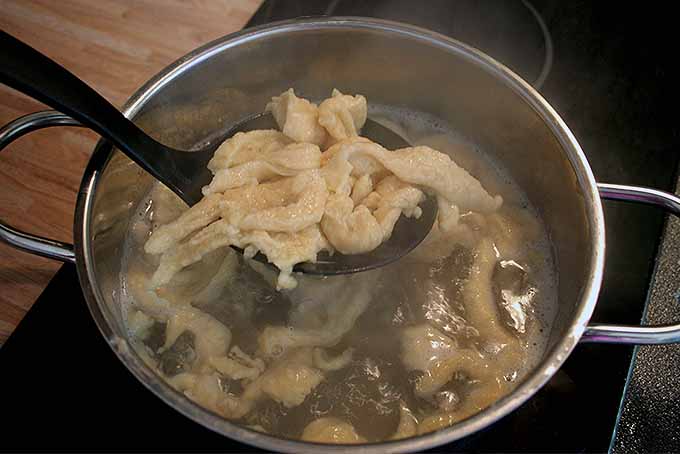
Step 4 – Serve!
Toss with butter and a sprinkling of salt and pepper, and serve immediately. Or, you can add an extra step like I have done here and lightly pan fry in butter until light brown and a bit crispy. Serve sprinkled with grated cheese, crumbled bacon, chopped fresh herbs, or sautéed onions.
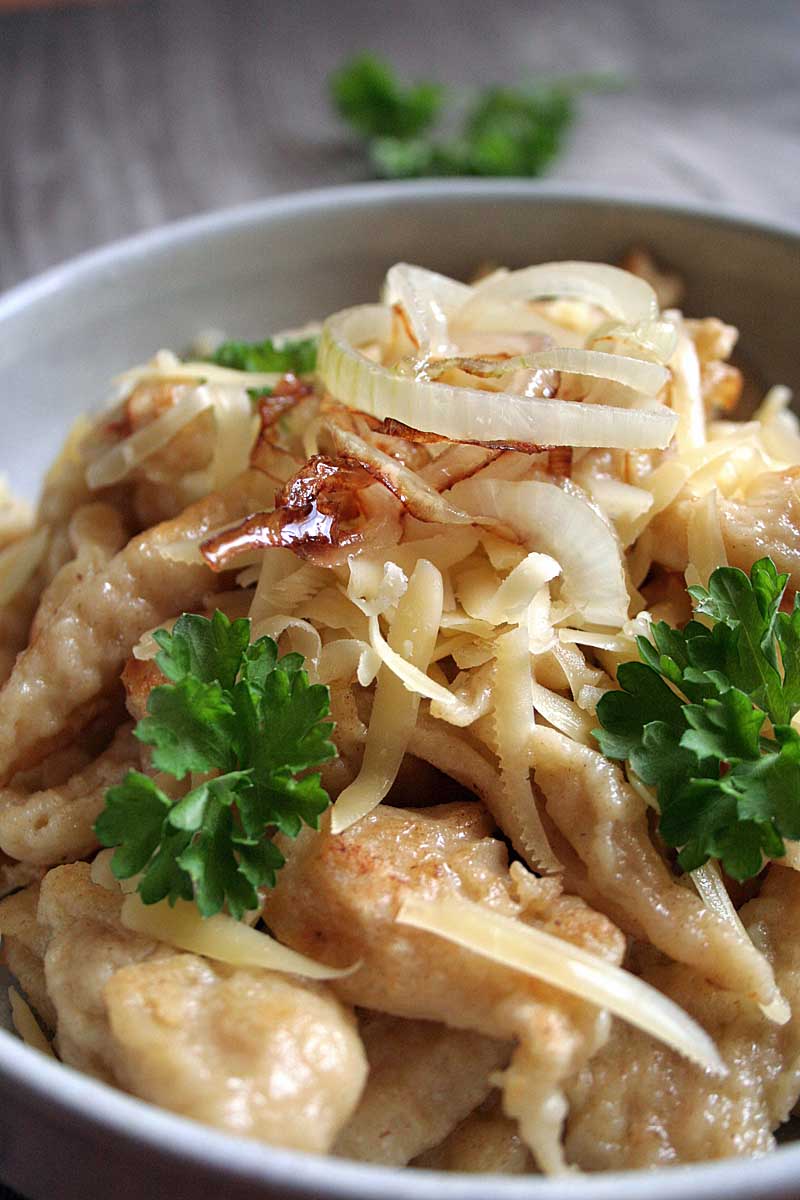
Do you have a favorite German-style noodle or method of serving it? Share with us, in the comments!
Originally posted March 23, 2015. Revised and updated August 15, 2018. Photos by Nina-Kristin Isensee, © Ask the Experts, LLC. ALL RIGHTS RESERVED. See our TOS for more details. Additional writing and editing by Allison Sidhu.
About Nina-Kristin Isensee
Nina lives in Iserlohn, Germany and holds an MA in Art History (Medieval and Renaissance Studies). She is currently working as a freelance writer in various fields. She enjoys travel, photography, cooking, and baking. Nina tries to cook from scratch every day when she has the time and enjoys trying out new spices and ingredients, as well as surprising her family with new cake creations.

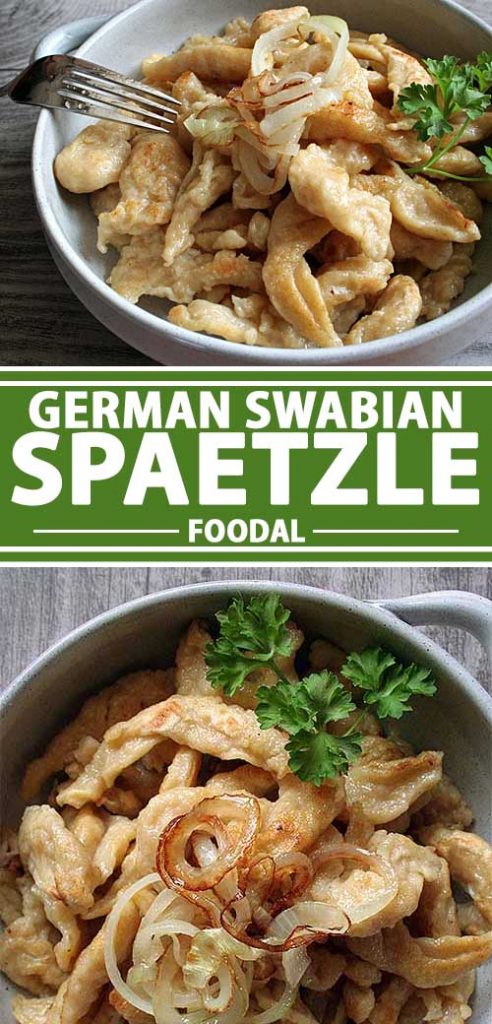
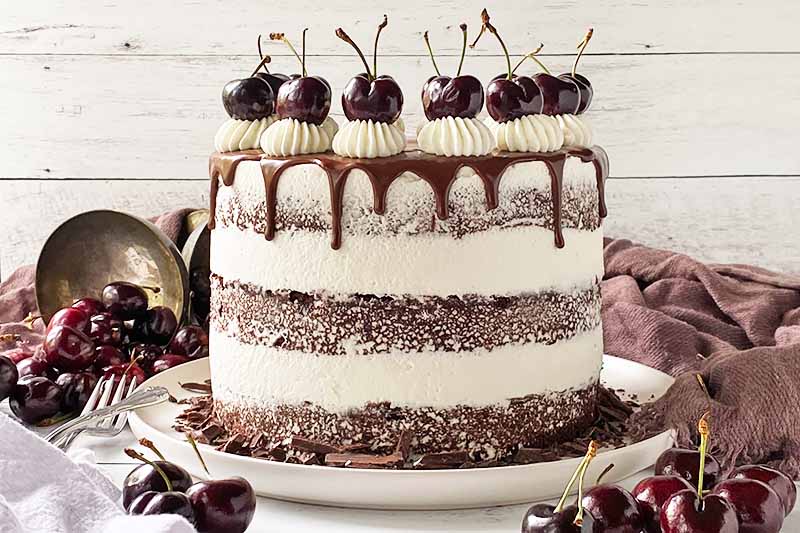

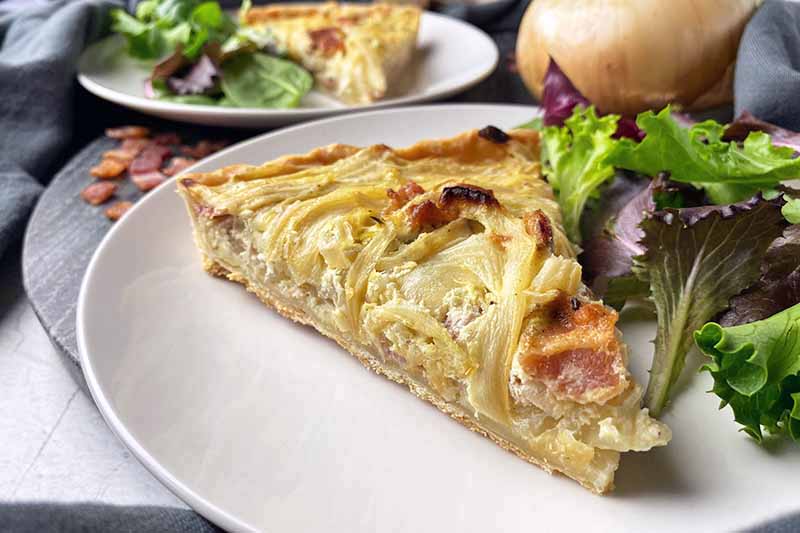
These look so wonderful and simple to make.
I can’t help thinking that they would go really well with a wild garlic pesto served with basil, rocket & parsley leaves for a wonderful lunch or have added peas and beans, served with a soft boiled egg for a good evening meal. I can see ideas for an evening meal next weekend.
I can also see that they would make an exceptionally nice green spaetzle if rocket or even pureed nettle were to be added to them in the mixing stage – reducing the water or eliminating it completely. It would make them bright green which would be excellent, then just fried off, served with some wilted herbs and oil over a salad. Ideas, ideas…
I get immediately hungry when I read your comment! Trning your spaetzle green makes them not only extra tasty but also special to look at, that is a nice idea! One could also consider using spinach or pureed basil I think.
I don’t know if this is still considered fusion food, but I would call it that anyway. This is clearly heavily influenced by traditional Italian pastas because they don’t use tomatoes for their sauce. It’s a simple recipe but it works.
I’ve always had a hard time utilizing spaetzle in a dinner scenario. I guess it’s due to the thickness of the ‘noodles’. I can easily work it into a dessert but I blame that on the flaming German in my blood. I also blame my need to utilize things on that same thing.
Oh man, I remember eating spaetzle during my time in Germany. No offense to the Italians, but these noodles to me were more flavorful (although I prefer the texture of a good pasta). I never knew it was so easy to make them, I always assumed it took some fancy flour or specialty noodle maker.
The dish with cheese and bacon bits look SO GOOD. I’ll keep this recipe in mind for when I’m in the mood to make something from scratch
I can’t imagine an easier recipe, and it seems with these ingredients, it would be hard to go wrong. Even if the end product doesn’t resemble the picture, I’m sure it would taste lovely. I like your idea of roasting them in a pan with some butter, and/or serving with grated cheese, both sound delicious.
Well I’ve never tries spaetzel before. It looks really great with the cheese but I’m not so sure about the recipe. I think I should try it at a restaurant before trying to make it myself.
Sure, why not? If you can find a restaurant that sells it, go for it and have a try. Although I can only encourage you to prepare them on your own, too. What makes you uncertain about the recipe? Maybe I can help you out here. One might need a bit patience in the first place, but if you like pasta, I’m sure you will enjoy them, too.
Wow! I have never had this dish and was not aware of it. You are right it does appear to be a lot softer and more fragile than Italian pasta. I must say that I do think I would like to try it out. I am very open to trying different types of dishes from other countries. i am interested in German foods.
Happy to hear that, I also like to try out other countries’ recipes. One always gets to know new combinations, textures and flavors, it can really boost one’s kitchen-creativity, too.
I hope you have fun preparing this special kind of pasta and bring some German twist into your dish 😉
Every time I open foodal and browse for recipes, I always find myself amazed! Like oraclemay, I have not heard of this dish before. This is why I’m so appreciative of Foodal as it continuosly introduce recipes that aren’t typically found in other websites. Danke!
Gern geschehen (You’re welcome!) 🙂
Thank you, I’m happy to hear that you constantly enjoy the diversity of recipes! I will be on the lookout for interesting new dishes to introduce to you and hope they find their ways into your kitchen!
So a more moist and softer version of macaroni? That is what I took away anyways, but either way it sounds like something that I would love to try. It reminds me of my girlfriend’s family, who is German, and all the crazy dishes and their names for them that they have, and this one certainly fits in well there. It looks delicious, and I always enjoy trying new things, so thank you.
When I first saw the image of the swabian spaetzle my first thought was “I don’t know what that is, but I want to taste it!” It just looks so great. I’ve never heard of that one before, but I’m into trying new things. One of these days when I feel competent enough in the kitchen to try something new, I will certainly try this one out.
Spaetzle is a delicious food that is extremely easy to make. Just looking at your post made me want to go back to Germany and try some. The best Spaetzle I have ever had was in Germany, but I would like to think that mine is almost as good as the ones that I have tried while in Germany. This is a great dish and a great recipe!
Besides pasta it looks like Pig Chicharron, it definitely looks great, tasty and really attractive to taste seekers eyes. It will be really hard to find that kind of pasta in my town, but, it’s still good to look at it through my screen. Thank you for sharing it.
We had this at a lot of holiday meals. My relatives and family have been quite Americanized, and we tend to call any pasta topped with onions, bacon, and herbs “spaetzle” You never put tomato sauce on pasta in the Klughaur family! It’s nice to see the authentic version. It would be fun to make this and bring it for Christmas dinner. Maybe some of my older relatives would recognize it in its original form!
This looks really tasty, especially sauteed with the onions. This could work as a meal or even as an interesting side dish. I’m always on the look out for new and unique sides. I don’t want my menus to get too boring. This will definitely help in that department.
My favorite part is the simplicity. I’ve generally thought of making homemade “pastas” (sorry) as intimidating, but since I’ve been coming to this site, I’ve learned that it isn’t so bad. This one seems simple enough for me to give it a try. Now, I just need to figure out what to make with it…
I plan to try this with casava flour to make it low carb. It may or may not work. Our daughter’s fiance cannot have gluten, so I am trying everything with nonwheat flours. Have you ever made it gluten free?
I love spätzle! I’ve never made them but your recepie makes me want to try one of these days.
It seems spaetzle are eaten in quite a few countries in Europe around Germany, under different names too. This simple Swabian delight has spread far and wide. My Gran who was from Denmark even used to make these straight into a big pot of chicken soup where they stayed as part of the dish. They’re fantastic, with that very particular soft fine delicate texture. Eaten in soup they flesh out a basic pot of soup so that it can feed many, in an instant basicaly.
I have also eaten them in Austria when visiting my sister who works in Vienna, but I had them with Emmentaler and cripsy onions as a street food somewhere, I can’t quite remember, it was cold and this was just the ticket.
Extreme comfort food. Im getting hungry just thinking about it, which is a little problem if you are watching your kilo’s. I nice Alpine walk before is the way.
I think the hand made ones off a board are more chracteristic as they get a more interesting and practical shape to hold toppings. The ones pushed through a sieve do look a lot like worms, not that that bothers me at all lol but they are practicaly white worms rather than the “little sparrows” from where spätzle gets their name. Though to be honest I don’t see much of the little sparrows either. I wonder if they had a different shape a long time ago?
I love me some spaetzle! Thanks for the recipe!
★★★★★